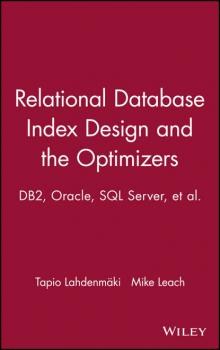Mike Leach
Список книг автора Mike LeachRelational Database Index Design and the Optimizers
Improve the performance of relational databases with indexes designed for today's hardware Over the last few years, hardware and software have advanced beyond all recognition, so it's hardly surprising that relational database performance now receives much less attention. Unfortunately, the reality is that the improved hardware hasn't kept pace with the ever-increasing quantity of data processed today. Although disk packing densities have increased enormously, making storage costs extremely low and sequential read very fast, random reads are still painfully slow. Many of the old design recommendations are therefore no longer valid-the optimal point of indexing has come a long way. Consequently many of the old problems haven't actually gone away-they have simply changed their appearance. This book provides an easy but effective approach to the design of indexes and tables. Using lots of examples and case studies, the authors describe how the DB2, Oracle, and SQL Server optimizers determine how to access data, and how CPU and response times for the resulting access paths can be quickly estimated. This enables comparisons to be made of the various designs, and helps you choose available choices for the most appropriate design. This book is intended for anyone who wants to understand the issues of SQL performance or how to design tables and indexes effectively. With this title, readers with many years of experience of relational systems will be able to better grasp the implications that have been brought into play by the introduction of new hardware.
Practical Flow Cytometry in Haematology Diagnosis
The accurate diagnosis of haematologic malignancies is a complex and challenging task. It routinely involves morphologic, molecular, cytogenetic and flow cytometric expertise. To determine what treatment protocol will be followed, it is vital to integrate, interpret and report these results accurately. Flow cytometry is key in this diagnostic pathway. This book guides the reader as to how flow cytometry results should be interpreted and applied to optimize patient care. At the core of this text is an appreciation of clinical, morphological and immunophenotypic correlation and the importance of constant liaison and discussion between the medical and scientific teams. The authors present a logical and practical approach to the diagnosis of blood disorders (both neoplastic and reactive) and evaluate the diagnostic applications of flow cytometry. Practical Flow Cytometry in Haematology Diagnosis provides: • A clinical reference source on all aspects of flow cytometry, covering both malignant and benign conditions • Carefully chosen real-life cases in each chapter, complemented by high quality morphological images • Help in making a diagnosis, together with an understanding of the limitations of the technique and the potential pitfalls All those who instigate, perform, interpret or act upon flow cytometry patient material will find this book an invaluable guide.
Practical Flow Cytometry in Haematology. 100 Worked Examples
The analysis of blood, bone marrow and tissue fluid specimens requires a multi-faceted approach with the integration of scientific data from a number of disciplines. No single discipline can operate in isolation or errors will occur. Flow cytometry is in a privileged position in that it can provide rapid analysis of specimens and it is often the first definitive investigation to produce results and help formulate a working diagnosis. This companion text to Practical Flow Cytometry in Haematology Diagnosis contains 100 worked examples drawn from real clinical cases presenting to the authors’ institution. Cases are illustrated with peripheral blood and bone marrow cytology, tissue pathology and cytogenetic and molecular data, which are integrated to generate, where appropriate, a diagnosis based on the WHO Classification of Tumours of Haematopoietic and Lymphoid Tissues. The spectrum of clinical cases includes adult and paediatric patients, and both neoplastic and reactive disorders. The cases appear in no particular order to challenge the reader to make their own diagnosis. The reader will review May−Grünwald−Giemsa (MGG)-stained films of peripheral blood and bone marrow aspirates presented alongside flow cytometric data and haematoxylin and eosin (H&E)-stained bone marrow and other tissue biopsy sections. Immunohistochemistry is used to further clarify the tissue lineage and cell differentiation. Cytogenetic studies using metaphase preparations are used to identify translocations and chromosome gains and losses whilst interphase fluorescence in situ hybridisation (FISH) studies and polymerase chain reaction (PCR) are used to identify gene fusions, gene rearrangements and deletions. Each case concludes with a discussion of the features that are important to making a diagnosis. The cases are also listed according to disease classification in the appendix so that the text can also be used as a reference. Practical Flow Cytometry in Haematology: 100 Worked Examples: Provides a practical, example-based resource for flow cytometry Demonstrates how flow cytometry results should be interpreted and applied to optimize patient care Includes both malignant and benign conditions Can be used in conjunction with Practical Flow Cytometry in Haematology Diagnosis, by the same author team (ISBN 9780470671207) Practical Flow Cytometry in Haematology: 100 Worked Examples is ideal for practicing haematologists and histopathologists with an interest in haematopathology, but particularly directed at trainee haematologists and scientists preparing for FRCPath and related examinations.


